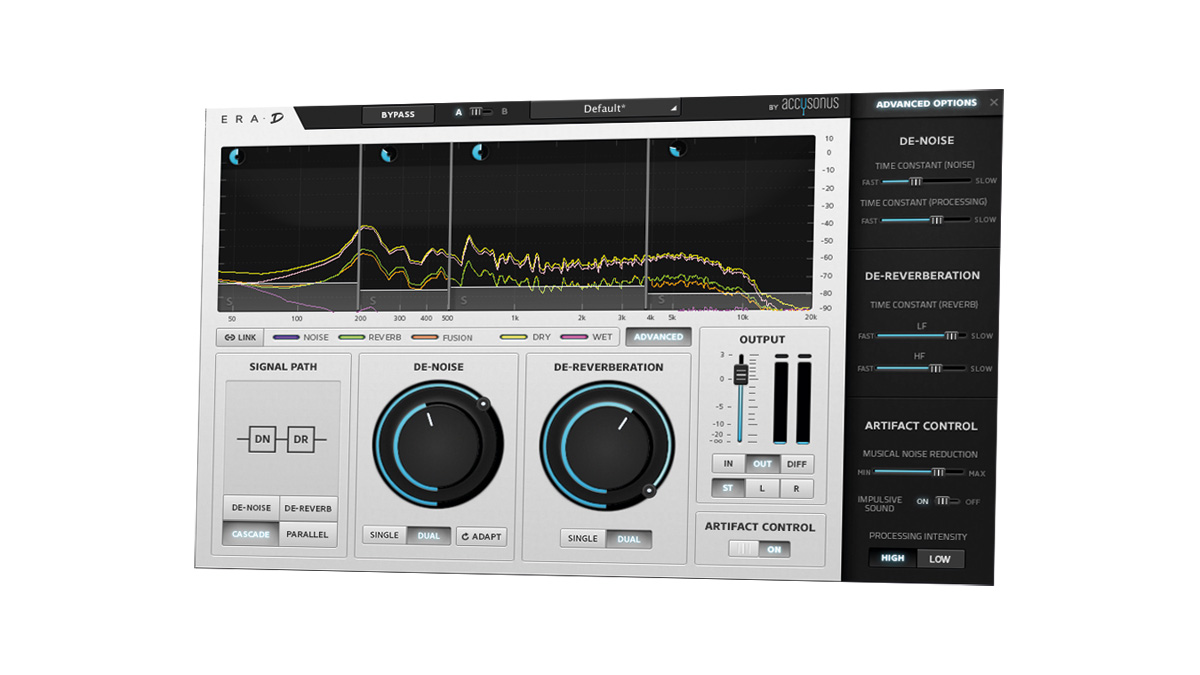MusicRadar Verdict
Although Era-D only reduces reverb, it does a great job of drying out source material, and noise reduction is a bonus.
Pros
- +
Noise and reverb suppression. Dual mode for complex stereo signals. Serial and Parallel routing. Good real-time display.
Cons
- -
Reverb can only be suppressed, not rebalanced.
MusicRadar's got your back
Era-D (AU/VST/AAX) is a dual-engine plugin combining noise and reverb suppression.
It comprises four processing modules - Signal Path, De-Noise, De-Reverberation and Artifact Control - with an Output module providing stereo or mono (left or right) monitoring of the wet, dry and wet/dry difference signals.
De-Noise and De-Reverberation each operate in Single or Dual mode, the former handling the input as a mono or dual mono signal, the latter taking into account the left and right differences in stereo signals.
Single mode consists of just a reduction control, so it's very straightforward to use. For complex stereo signals, more extreme reduction is achieved using Dual mode, in which a second reduction knob appears, addressing the cross-channel elements of the noise or reverb, but making getting the reduction amount right more of a juggling act.
The fold-out Advanced Options panel holds more controls. For De-Reverberation, these include low and high frequency sliders, which set the speed at which the suppression is applied to the low and high frequency signal components.
For De-Noise, you get a single Time Constant slider (Fast to Slow) that adjusts the overall speed of adaption to changes in noise levels. This is joined in Single mode by a processing Type option, with three increasingly strong noise reduction curves, which is replaced in Dual mode by a further Time Constant slider that fine-tunes the response for the L-R difference aspect of stereo signals.
Noise and reverb removal tend to create artifacts that become more obvious as the processing increases, and in that respect, Era-D is similar to other competing processors.
However, the Artifact Control switch alleviates it considerably. This is joined by some Advanced parameters, including Processing Intensity (Low/High) and two smoothing options: Musical Noise Reduction and Impulsive Sound, the second designed for percussive source material.
A golden Era?
Era-D's spectral display incorporates five coloured plots: Noise, Reverb, Fusion (reverb and noise combined), Dry (unprocessed) and Wet (processed). It also enables reverb and noise reduction to be applied across four discrete frequency bands, with per-band Range and Intensity controls, as well as individual Band Solo and adjustable crossovers.
Range is simply a threshold control, setting the level at which processing kicks in, and at zero (right up to the top) no processing is applied to that band. Intensity is a non-linear option that focuses on the frequencies at which analysed noise and reverb are prominent. Once again, at zero, no processing occurs for that band.
The multiband section is applied after the main De-Noise and De-Reverberation controls (which are wide-band), and so is meant to be used to fine-tune how much the two modules influence each band. Nevertheless, it's still a very powerful option that can dramatically influence the final result.
If we have one gripe with Era-D, it's that it only focuses on suppression, so rebalancing the reverb element by boosting it isn't an option. That doesn't detract too much from what is otherwise an excellent plugin, though, achieving just the right balance between ease of use and behavioural fine-tuning.
Computer Music magazine is the world’s best selling publication dedicated solely to making great music with your Mac or PC computer. Each issue it brings its lucky readers the best in cutting-edge tutorials, need-to-know, expert software reviews and even all the tools you actually need to make great music today, courtesy of our legendary CM Plugin Suite.
“A synthesizer that is both easy to use and fun to play whilst maintaining a decent degree of programming depth and flexibility”: PWM Mantis review
“I feel like that song had everything we needed to come back with”: Bring Me The Horizon’s Lee Malia on Shadow Moses, its riff and the secrets behind its tone, and why it was the right anthem at the right time
“I said, ‘Are we sure we can write a song about death?’”: The story of Mike + The Mechanics' classic No.1 The Living Years











